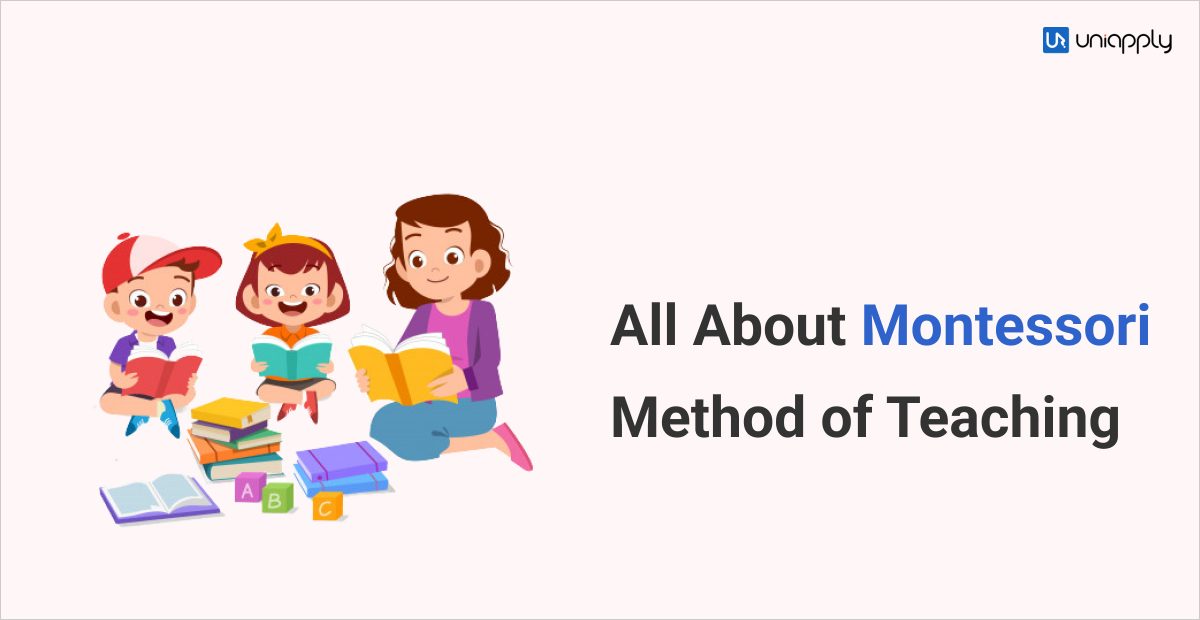What is the Montessori Method of Teaching?
Introduction
We know finding a preschool can be an irksome cycle. This pursuit of finding the perfect preschool depends on myriad factors such as the teaching mechanisms followed in schools, openings in schools, and the potential child growth of students after attending the preschools. Thus, gaining clarity on these diverse facts might get difficult and puzzling for any parent while finalizing a school. In order to gain more clarity in their decision-making in finding the right school, it is important to understand the various teaching philosophies, the pros and cons of each environment, and the diverse curriculums taught in schools to make you feel more confident while finalizing the right preschool for your child. In this blog, we are going to discuss the Montessori method of teaching in preschools which formulates to be one of the important methods of teaching followed in preschools along with its various pros and cons attached to it.
What is Montessori Education?
Montessori is a method of education that is based on self-directed activity, hands-on learning, and collaborative play. Its fundamental point is to empower the kids to settle on inventive decisions in their learning. This homeroom learning jointly drove by profoundly prepared educators offers age-proper exercises to direct the interaction. Kids work in gatherings and independently to find and investigate the information on the world and to foster their greatest potential. Montessori homerooms are flawlessly created conditions intended to address the issues of youngsters in a particular age range.
Pioneer of Montessori Education:
The Montessori Method was created by Dr. Maria Montessori in the mid-1900s. It’s a particular youngster-focused strategy for training that includes kid drove exercises (alluded to as “work”), study halls with offspring of changing ages and instructors who empower freedom among their students. Dr. Maria Montessori found that experiential learning in this kind of study hall prompted a more profound comprehension of language, math, science, music, social communications, and significantly more. Most Montessori homerooms are common in nature, albeit the Montessori instructive technique can be incorporated effectively into a religious program.
Dr. Montessori accepted that youngsters learn better when they’re picking what to realize, and that way of thinking is available in Montessori homerooms today. A Montessori study hall probably appears to be unique than what you’re utilized to.
The Association Montessori Internationale (AMI) was set up by Maria Montessori in 1929 to secure the honesty of her work and to help elevated expectations for both educator preparing and schools. Today, AMI keeps on maintaining Maria Montessori’s vision while teaming up with contemporary exploration in neuroscience and kid improvement. Montessori Northwest is glad to be an authority educator preparing focus of AMI, preparing instructors to work with youngsters from birth to age twelve.
The Pros and Cons of Montessori Teaching are Listed Below:
|
Pros |
Cons |
|
|
The Advantages of Montessori Teaching are:
Hands-on Learning
Montessori study halls are fairly renowned for their excellence. Loads of normal light and space are normal needs in the study hall plan. This is a completely finished explanation. “Establishing an excellent and available climate is of principal significance, as youngsters direct their own learning with the assistance of carefully planned learning helps,” says Karen Ricks, who established a worldwide Montessori school in Japan. The best thing about a Montessori environment is that it allows for children to work, develop and learn at their own individual pace,” says Anitra Jackson, Montessori educator and writer of Chronicles of a Momtessorian. Children are exposed to lessons, activities and materials that build upon their skill set—they progress in their development as an individual.Things that make it one of a kind include the Different action stations for kids to browse for the duration of the day. Additionally, Instructors move from one gathering to another as opposed to remaining at the front of the study hall.
Enhanced Social Communication
Have you at any point saw the manner in which kids become intrigued by the thing different youngsters are doing? Montessori exploits that by gathering offspring of various ages in similar learning conditions. It is believed that most Montessori study halls blend age and experience to encourage shared learning. This plan can normally prompt development that probably won’t happen in an all the more consistently matured study hall. “These blended matured gatherings take into consideration kids to gain from each other, show each other and foster fundamental abilities like incorporation and acknowledgment,” quoted by a leading educator.
Feeling of Autonomy
It is believed that Montessori education delivers the esteemed feeling of certainty and artistic liberty that one can create which fosters an innovative range of abilities. Since a large part of the learning system is self-coordinated, kids can acquire a feeling of autonomy and trust in their capacities a lot quicker than in a conventional school setting. Additionally, students who experience a Montessori teaching will more often than not be more ready to oversee themselves and think autonomously.
Developed Love for Learning
This instructive way of thinking endeavors to empower an adoration for learning. This specific advantage can remain with youngsters their whole lives and become a moving power through optional instruction, a profession, work preparing – or even in the encounters they have and individuals they experience. It is believed that kids can have a longing and a capacity to associate with an assortment of individuals and thoughts in various circumstances and settings.
Comprehensive of Unique Requirements
Maria Montessori’s vision for instruction included kids with exceptional requirements from the earliest starting point. In addition to the fact that she studied scholarly and formative handicaps, yet she was the co-overseer of an organization for custom curriculum educators. It was with this background that she started her first “Casa Dei Bambini” (Children’s House) for disenfranchised children in Rome in 1907. Many of the tenets of Montessori education serve students with special needs well. As children are grouped with others of different ages and have the same teacher for three years at a time, students with special needs tend to have less pressure to keep up with their peers and more freedom to learn and grow at their own pace. The classroom continuity can also help students with special needs form close connections within their classroom, making for a safe and stable environment in which to learn. Montessori’s “follow the child” philosophy allows for all children – not just those with special needs – to receive an individualized education. A Montessori instructor’s lesson plan may have each child’s name on it with different goals and ideas for their unique learning style. This especially helps students with special needs to learn at their own pace.
The Disadvantages of Montessori Schooling:
Obviously, it is not necessarily the case that each involvement with Montessori will be a decent one. On one side, educators, cohorts, and school organizations can truly affect your experience to improve things. What’s more on the opposite side, there are a few parts of the Montessori culture that can cause issues for some.
Not Cost Friendly
It is hard for Montessori schools to keep their costs low. The procurement of so many sturdy and top-notch learning materials, just as the extended and inside and out preparing in the utilization of such things for small kids is a costly endeavor which is the reason most completely carried out Montessori programs are costly.
Not Open to Everybody
For some, Montessori education has gone hand in hand with being white and privileged. While this is nowhere near Maria’s original vision for Montessori, it is unfortunately the norm. Because this education philosophy flips traditional public-school curriculum on its head, most Montessori programs are private, tuition-charging and admissions-regulating. This makes it disproportionably difficult for low-income, inner-city students of color to attend such schools. There are, however, some Montessori charter schools that are more accessible. The National Center for Montessori in the Public Sector reports that out of the 5,000 Montessori schools in the U.S., there are about 500 public programs.1 They are typically located in more diverse areas and federally-funded, removing the tuition barrier.
Curriculum Maybe too Loose for some
While “following the kid” ought not be deciphered as “let kids do whatever they want,”it is as yet a less-organized educational plan than what you may find in a more normal methodology. It is up to the instructor and partner to ensure kids progress on pace. In a perfect world, this compromise can function admirably. Yet, it can likewise make space for certain subjects to drop off the radar. It would change the detachment of the educational plan to thinking back on their own insight.
Unrestricted Autonomy can be Harmful
Montessori is solid in encouraging a feeling of freedom and independent work. Yet,the open-finished construction of the homeroom can be scary for some Kids will quite often like everyday practice and design. Indeed, even the actual boundaries of work areas arranged straight can be a solace to specific understudies. Montessori homerooms are worked to permit development and change and the educators will quite often direct more than straightforwardly teach. While this is probably not an insurmountable obstacle, it’s definitely something to bear in mind. The hierarchy of traditional classrooms allows less freedom to the students, but it can also ensure a class environment that feels ordered, safe and routine.
Conclusion
Each material in a Montessori homeroom upholds a part of kid advancement, making a match between the kid’s regular advantages and the accessible exercises. Kids can learn through their own insight and at their own speed. They can react at any second to the regular interests that exist in all people and construct a strong establishment forever long learning.
Also Read:
- What is IGCSE Board – Full form & Advantages of IGCSE Board
- What is ICSE Board – Full form & Advantages of ICSE Board
- What is CBSE Board – Full form, History & Advantages of CBSE Board
- CBSE vs ICSE: What Is the Difference Between CBSE and ICSE Board?
- What is IB board – Full form, History & Programmes of IB Board?






